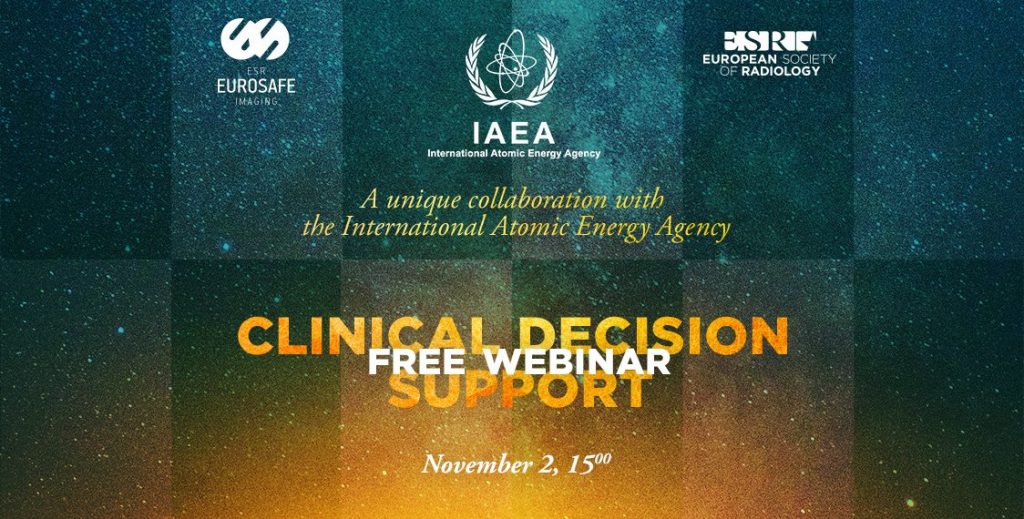Clinical Decision Support
Webinar
Date: November 2, 2017, 15:00 (CET)
Presenters: G. Frija, L. Donoso-Bach
Recorded broadcast: available here

About the webinar:
EuroSafe Imaging is the European Society of Radiology’s flagship campaign to promote quality and safety in medical imaging. The mission of EuroSafe Imaging is to support and strengthen medical radiation protection across Europe following a holistic, inclusive approach. EuroSafe Imaging is pleased to hold this webinar on Clinical Decision Support together with the IAEA Radiation Protection of Patients Unit.
Clinical Decision Support (CDS) systems are used to make imaging referral guidelines available and usable at the point of care. By providing information to referring physicians on the appropriateness of different modalities for a given clinical indication, CDS supports them in referring
In Europe, imaging referral guidelines exist in all member states as mandated by the Euratom BSS directive. However, awareness of guidelines is limited while the use of guidelines is minimal, according to an ESR-led study funded by the European Commission (2013). To address this situation, the ESR started the ESR iGuide initiative.
CDS is a proven way to increase the use of guidelines and thereby improve appropriateness in medical imaging. CDS systems are most effective when implemented within existing workflows through integration into electronic medical records or CPOE (Computerised Physician Order Entry) systems.
The adoption of CDS in the United States, where ACR Select has been available since 2012, is widespread and has been driven by healthcare legislation mandating the use of accredited CDS systems for imaging referrals from January 1, 2019. Studies have shown that CDS significantly reduces the number of inappropriate imaging exams.
Since 2016, pilot projects have started in Europe to introduce ESR iGuide in various countries. Initial results from Croatia demonstrate that the use of CDS can improve the rate of appropriate referrals from 75 percent to almost 80 percent. At the Hospital Clinic Barcelona, imaging referrals were deemed appropriate 89 percent of the time following the introduction of CDS. The statistics and analysis capabilities that CDS systems provide offer important insights for improving clinical practice and further improving the adherence to evidence-based guidelines.
Learning objectives:
- To become familiar with EuroSafe Imaging and how to engage;
- To understand how clinical decision support works;
- To learn more about imaging referral guidelines in Europe;
- To learn more about the educational benefits of embedding guidelines in the clinical workflow;
- To understand the benefits for implementing CDS for radiologists, referrers and patients.
Biographies:
 |
Guy Frija is Professor Emeritus at Université Paris Descartes (FR), Professor at Mac Master University (CA), radiologist consultant at the Paris Georges Pompidou European Hospital (FR), and chair of EuroSafe Imaging, a multi-stakeholder and holistic approach of radiation protection based on the IAEA/WHO Bonn Call for Action, an initiative of the ESR. During his various positions in the European Society of Radiology (ESR), he also stimulated the setting up of a radiation protection committee. He was involved in the development of ESR’s clinical decision support system for improving the justification process. He has published more than 150 articles in peer review journals. |
 |
Prof. Luis Donoso-Bach has led the Diagnostic Imaging Department at the Hospital Clínic of Barcelona and has served as Professor of Radiology at the University of Barcelona since 2016. He is also Executive Director of the UDIAT Centre Diagnòstic Cetre, Sabadell since 1998. Prof. Donoso-Bach has given numerous lectures at prestigious universities, congresses, and courses. Altogether, he has published over 90 articles and seven book chapters. In addition, Prof. Donoso-Bach has always been active in the professional societies, from the regional to the international level, in particular at the European Society of Radiology (ESR), where he has served in various positions since 2000. |
